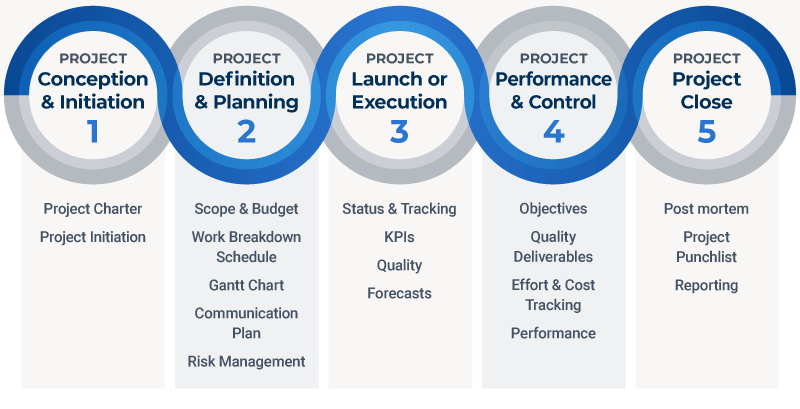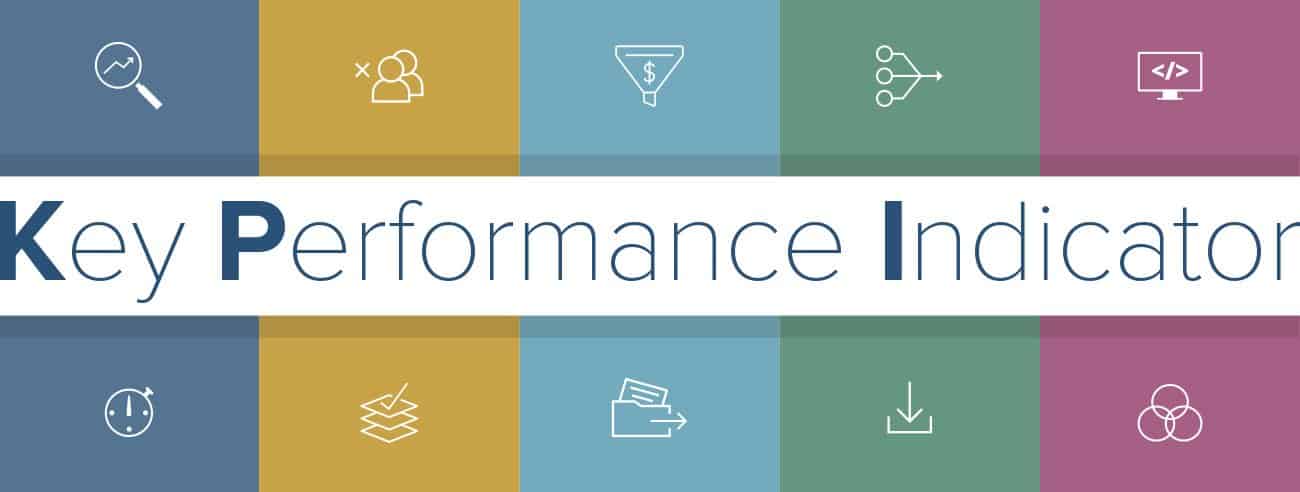PMBOK® Guide Concept of the Project Life Cycle
According to the PMBOK® Guide, the elements of a project lifecycle should define the work the project will accomplish, the deliverables it will produce, the team members involved, and how you will control and approve each project phase.
Determining these elements will take a project from start to finish. These project controls provide a systematic and timely process that benefits a project’s stakeholders. This helps PMs define what needs to be accomplished before moving onto the next phase of a project.
Simple, powerful project management with Smartsheet. See for yourself.
Smartsheet is a cloud-based platform that allows teams and organizations to plan, manage, and report on projects, helping you move faster and achieve more. See Smartsheet in action.
Project management that adapts to your needs
Work with flexibility and security—from small projects to large-scale processes and entire portfolios.
Smartsheet helps you break down projects into tasks, track progress, and manage resources, budgets, and workflows—all in one unified platform for seamless collaboration and delivery.
5 Phases of Project Management
Project management can be divided into five phases. First, stakeholders initiate the project, and then define and plan it. Next, the team executes the project and monitors its performance. Finally, once the project is completed, it must be closed out.
Download a Phased Project Plan Template for
PowerPoint
| Google Slides
Phase 1: Project Initiation
The goal of project initiation is to broadly define the project. This process usually begins with a business case or project charter. If research or feasibility testing is necessary, you should complete it during this phase.
Important stakeholders will do their due diligence to help decide if the project is a “go.” If it is given the green light, you will need to create a project charter or a project initiation document (PID) that provides an overview of the purpose and requirements of the project. It should provide a description of the business needs, stakeholders, and the business case. Note: There are plenty of PID templates that adhere to PMBOK® Guide guidelines available online that you can download to help you get started.
Tip: When creating a PID, don’t get too bogged down in technical requirements. Those will be clarified and clearly defined in Phase 2.
Phase 2: Project Planning
The planning phase is key to successful project management and focuses on developing a roadmap for the team to follow. During the planning phase, project managers should organize their teams, set up collaborative resources, and set goals.
Two of the more popular methods for setting goals are S.M.A.R.T. and CLEAR:
S.M.A.R.T. Goals – This method helps ensure that the goals have been thoroughly vetted. It also provides a way to clearly understand the implications of the goal-setting process.
Specific – To set specific goals, answer the following questions: who, what, where, when, which, and why.
Measurable – Create criteria that you can use to measure the success of a goal.
Attainable – Identify the most important goals and what it will take to achieve them.
Realistic – You should be willing and able to work toward a particular goal.
Timely – Create a timeframe to achieve the goal.
For more information about S.M.A.R.T. goals and to download free S.M.A.R.T. goal templates, read "The Essential Guide to Writing S.M.A.R.T. Goals."
C.L.E.A.R. Goals – A newer method for setting goals that takes into consideration the environment of today’s fast-paced businesses.
Collaborative – The goal should encourage employees to work together.
Limited – They should be limited in scope and time to keep it manageable.
Emotional – Goals should tap into the passion of employees and be something they can form an emotional connection to. This can optimize the quality of work.
Appreciable – Break larger goals into smaller tasks that can be quickly achieved.
Refinable – As new situations arise, be flexible and refine goals as needed.
During this phase, the scope of the project is defined and a project management plan is developed. It involves identifying the cost, quality, available resources, and a realistic timetable. The project plan also includes establishing baselines or performance measures. These are generated using the scope, schedule and cost of a project. A baseline is essential to determine if a project is on track.
At this time, roles and responsibilities are clearly defined, so everyone involved knows what they are accountable for. Here are some of the documents a PM will create during this phase to ensure the project will stay on track:
- Scope Statement – A document that clearly defines the project, including the business need, benefits of the project, objectives, deliverables, and key milestones. A scope statement may change during the project, but it shouldn’t be done without the approval of the project manager and the sponsor.
- Work Breakdown Schedule (WBS) –This is a visual representation that breaks down the scope of the project into manageable sections for the team.
- Milestones – Identify high-level goals that need to be met throughout the project and include them in the Gantt chart.
- Gantt Chart – A visual timeline that you can use to plan out tasks and visualize your project timeline.
- Communication Plan – This is of particular importance if your project involves outside stakeholders. Develop the proper messaging around the project and create a schedule of when to communicate with team members based on deliverables and milestones.
- Risk Management Plan – Identify all foreseeable risks. Common risks include unrealistic time and cost estimates, customer review cycle, budget cuts, changing requirements, and lack of committed resources.
To learn more about project management terms and documents, read our glossary of project management terminology.
Tip: When creating a WBS, work packages shouldn’t be longer than 10 days. Be sure to solicit the input and perspective from team members about their specific tasks.
Phase 3: Project Execution
During the project execution phase, the team develops and completes deliverables. This phase begins with a kick-off meeting, is marked by the onset of status reports and updates, and transitions into performance and monitoring as the project progresses.
Tasks completed during the Execution Phase include:
- Project introduction and kick-off
- Develop team
- Assign resources
- Execute project management plans
- Procurement management if needed
- PM directs and manages project execution
- Set up tracking systems
- Task assignments are executed
- Status meetings
- Update project schedule
- Modify project plans as needed
While the project monitoring phase has a different set of requirements, these two phases often occur simultaneously.
Tip: Consider using cloud-based project management software so team members can update task status in real time.
Phase 4: Project Performance and Monitoring
Project performance and monitoring ensures that project results align with the management plan. Project managers use key performance indicators (KPIs) to determine if the project is on track. We’ve outlined the most common KPIs for performance tracking below:
- Project Objectives: Measuring if a project is on schedule and budget is an indication if the project will meet stakeholder objectives.
- Quality Deliverables: This determines if specific task deliverables are being met.
- Effort and Cost Tracking: PMs will account for the effort and cost of resources to see if the budget is on track. This type of tracking informs if a project will meet its completion date based on current performance.
- Project Performance: This monitors changes in the project. It takes into consideration the amount and types of issues that arise and how quickly they are addressed. These can occur from unforeseen hurdles and scope changes.
During this time, PMs may need to adjust schedules and resources to ensure the project is on track
Tip: Review the business case at the end of each phase and make adjustments to the project plan as needed.
Phase 5: Project Close
Once a project is complete, the team must formally close it. Project managers generally hold a post mortem meeting to evaluate successes and failures. Project close helps a team identify things that went well and areas for improvement.
Once the project is complete, PMs still have a few tasks to complete before it is officially closed. They will need to create a project punchlist of things that didn’t get accomplished during the project and work with team members to complete them. Perform a final project budget and prepare a final project report. Finally, they will need to collect all project deliverables and documents and store them in a single place.
Tip: Using a cloud-based software solution is an easy way to collect and save all project documents in one location throughout the life of the project.
Smartsheet for Project Management
Empower your people to go above and beyond with a flexible platform designed to match the needs of your team — and adapt as those needs change.
The Smartsheet platform makes it easy to plan, capture, manage, and report on work from anywhere, helping your team be more effective and get more done. Report on key metrics and get real-time visibility into work as it happens with roll-up reports, dashboards, and automated workflows built to keep your team connected and informed.
When teams have clarity into the work getting done, there’s no telling how much more they can accomplish in the same amount of time. Try Smartsheet for free, today.



